Trieste: A unique Italian city with a central European twist, rich history, diverse culture, and scenic Adriatic charm.
Read more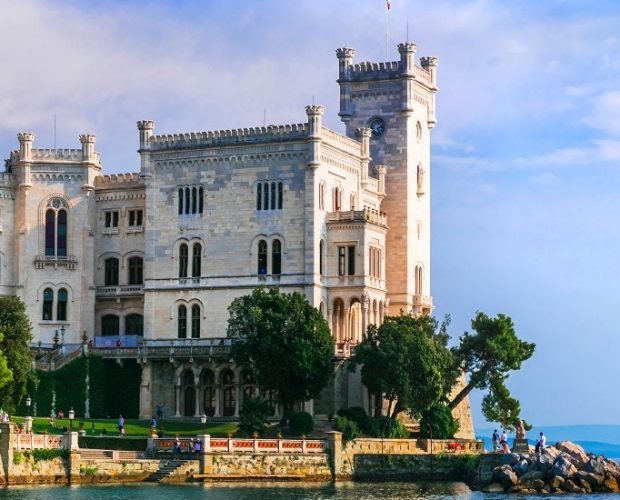
EXPLORE ALL OUR GUIDES TO THE BEST ITALIAN WINE REGIONS
Last updated: May 24, 2024
Situated at a crossroads of northeastern Italy, the Adriatic, Austria, and Slovenia, Friuli-Venezia is a poster child for multicultural Italy. Moreover, the region is unspoiled despite its rich history – Friuli was part of the Austro-Hungarian Empire until 1918 – and immense cultural treasures. But while there is a staggering amount of historical sights, from Roman ruins to Austro-Hungarian palaces, this is a destination where food and drink steal the show – both economically and culturally. You’re visiting Italy’s undisputed powerhouse of fine white wines: saline, aromatic, and beautifully complex. Of course, white winemaking has progressed enormously all over Italy over the past 20 years; regions as diverse as Trentino and Campania are now making exceptional whites. Yet the revolution started here, and Friuli-Venezia Giulia, to use its full moniker, remains in a league of its own.
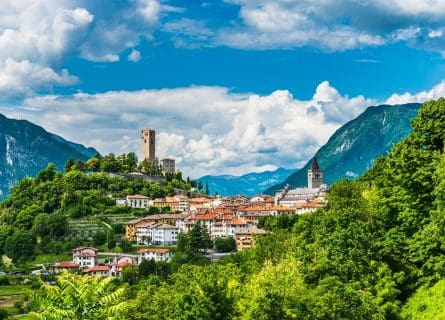
Winemaking in Friuli dates back to the ancient Romans. By the 2nd century BC, this once parochial culture had subjugated the Etruscan and Greek colonies along the Italian coastline; it won its most famous battles under Julius Caesar, the leader who conquered Gaul (France) and greatly expanded Roman territory. Rome became the capital of a sprawling empire, introducing its language, laws, and calendar to most of Europe. However, this grandiose political project turned to dust in the 5th century AD, as Germanic invaders overran the Western Empire from all directions.
The next few centuries, appropriately known as the ‘Dark Ages,’ were a rollicking, often blood-stained tale of conquest and reconquest. One of the earliest power shifts involved the Ostrogoths, a Germanic race who settled in Friuli during the chaos of the initial post-Roman period. However, they were ultimately defeated by the Lombards of Milan – the latter founded the Duchy of Friuli in the 6th century.
Yet even the Lombards could not stand against the combined forces of the Catholic Church and the Frankish Merovingians. The medieval papacy summoned the Franks to banish the Lombards from Italy – they took Friuli in 846. Unfortunately, for five centuries, popes and emperors fought to decide who should be responsible for their religious polity.
Meanwhile, northern Italy witnessed the rise of independent city-states, the most powerful being Venice. After growing wealthy from trade with the East, the Venetians acquired’ Friuli-Venezia in the 1400s. Yet the region did enjoy a certain amount of autonomy during this period, with its legislative chamber. Its economy flourished on the back of agriculture and commerce – Friulian wines became a massive hit across northern Europe in the 15th century.
But even the might of Venice could not compete with great powers; much of northern Italy came under the control of Austria in the 1600s, while the papacy controlled a small kingdom in the center. As part of the Austro-Hungarian empire, Trieste became a free port, attracting investors from Europe, Asia, and beyond.
By the 20th century, Italy was a unified state; however, Trieste had national traded alliances five times since the beginning of the 1900s! Thus, Friuli-Venezia was in the doldrums: wars, poverty, and a devastating earthquake saw mass migration to Argentina and Australia during the 1950s and 1960s. Meanwhile, its wine-growing industry was cursed by a lack of investment and poor winemaking. Yet modern commercial success came in the late 1960s when innovations in temperature control allowed producers (led by the famed Mario Schiopetto) to create crisp, clean white wines for the first time.
Many wine experts consider the advances made here as the first step in creating the trend toward fresher, lighter white wines. The trend continues today, and Friuli’s white wines (along with some whites made in the southern region of Campania) are considered the best in Italy.
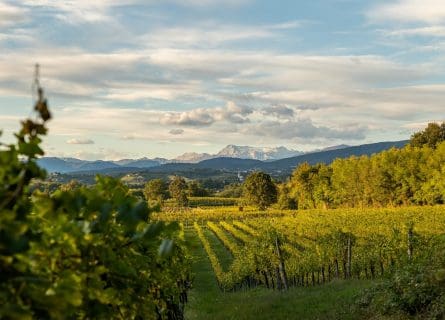
The vineyards of Friuli-Venezia are found in northeastern Italy, bordered by Slovenia to the East and Austria to the north. Interestingly, some of the vines planted in western Primorska are politically part of Slovenia, yet they belong geographically to Friuli. Indeed, some producers have vineyards on both sides of the border, commuting between the splendid cities of Trieste and Ljubljana.
Today, the wider region showcases four DOCG appellations, over 10 DOCs, and three Indicazione Geografica Tipicas (IGPs). The area under vine is expansive, running just south of Cividale del Friuli to the landscape southwest of Gorizia, on the border with Slovenia. As a result, Friuli has a wide variety of microclimates and terroirs, with a correspondingly broad spectrum of wine styles. Moreover, although over 80 percent of the total production is white, plenty of warm sites can ripen red varieties, including Cabernet Sauvignon, in most years.
The vineyards of Colli Orientali and Isonzo represent the two sides of Friuli wine-growing. Although the former is protected from harsh winds by the Alps in Slovenia to the northeast, the former enjoys a cool continental climate; winters are bitter, and summers can be long and dry. These eastern hills climb to about 350 meters above sea level and are endowed with mineral-rich soils that contain marl and sandstone deposits.
Meanwhile, the flatter vineyards of Isonzo in the south are far closer to the Adriatic and, therefore, enjoy a milder climate. Merlot is particularly successful in the well-drained vineyards north of the River Isonzo. However, the wines made on the lower, flatter, more fertile land between the river and the sea are often (but not always) less remarkable.
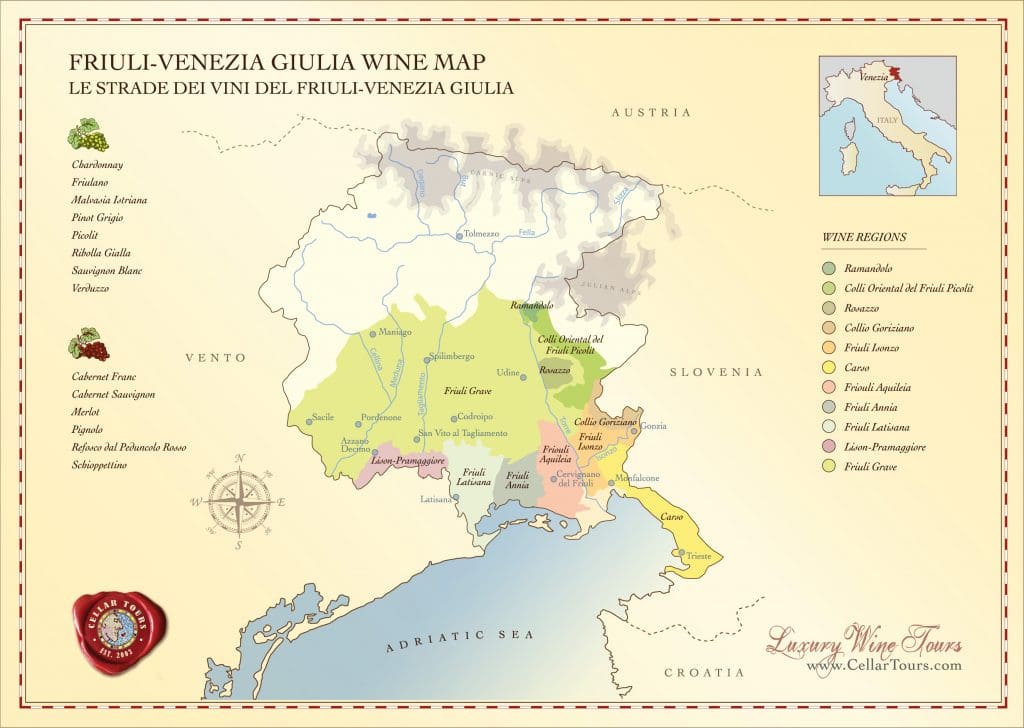
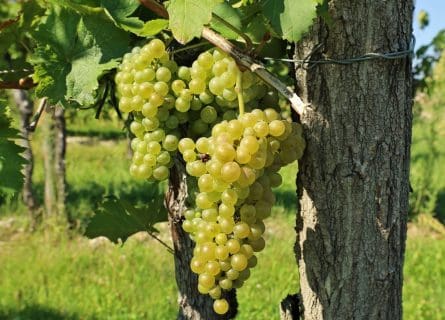
Friuli has established a strong reputation for the quality and consistency of its white wines. They are typically varietal, perfumed, sharply etched, clean as a whistle, and often unoaked. Yet, while the region has a signature style, its palate of grape varieties is as broad as its eclectic mix of terroirs and climates. The principal grape of Colli Orientali, Friulano, is one of the most commonly encountered in the zone.
Like the ubiquitous Sauvignon Blanc and Pinot Grigio, it yields very fruity wines that are usually subject to protective handling: the exclusion of oxygen, cool fermentation in stainless steel, malolactic fermentation, and lees stirring are all standard practices in the appellation. Sauvignon Blanc and Pinot Grigio are often treated similarly, satisfying global demand for saline whites that can be marketed at under $15. They are relatively easy (and cost-effective) to produce, although that is not to belittle the high standards of local winemaking today.
Meanwhile, over 30 percent of the vineyards of Colli Orientali are planted to red grapes. Cabernet Sauvignon and Merlot are becoming more popular. However, the indigenous Refosco and Schioppettino are making some of the most exciting wines in Friuli today: aromatically complex and silky reds that benefit from a period in oak, although too many new barrique will ruin everything.
Funnily enough, some of the vineyards once thought to be Cabernet Franc turned out to be Carmenere – the signature red variety of Chile. It makes a funky style of red in this corner of northeastern Italy, renowned for its bouquet of undergrowth, red currants, and a distinctly animal note. A surge of investment – and imported expertise – has contributed significantly to the continuing increase in general wine quality here, with better tannin management and less over-oaking.
The same could be said about the esoteric wines of Ramandolo DOCG. The appellation produces one of Friuli’s most underappreciated and unique styles: sweet Verduzzo with a pungent bouquet of honey, saffron, citrus, and stone fruit. A great deal of pride is also invested in Picolit, a dessert wine made from a (relatively) obscure local white grape. It is somewhat reminiscent of Petit Manseng – a flowery, sweet white with notes of honeysuckle and apricot. Yet, although we love to recommend the weird and wonderful to everyone, Verduzzo and Picolit are hardly significant cash cows for the region.
Collio Goriziano DOC, however, is a different matter. This appellation, located south of Colli Orientali, is an export powerhouse and a vital part of Friuli’s economy. It produces some of the area’s finest whites, based on a mixture of indigenous and international grapes that keep the accountants and consumers happy. Such is the insatiable demand for Pinot Grigio, which this variety long ago overtook Friulano in terms of acreage.
The critical mass of labels conform to the stereotype: fermented in stainless steel and bottled relatively soon after the harvest, Pinot Grigio is a quaffable – and perhaps forgettable – part of the Italian viticultural map. But the same cannot be said for Ribolla Gialla, a real local beauty. It yields gorgeously perfumed whites that invoke the best of Galicia with their clean fruit and racy acidity. The area under vine has recently increased as more and more oenophiles reject the familiar for the authentic.
Although it lacks the global renown of Piedmont and Tuscany, Friuli-Venezia Giulia is increasingly one of Italy’s most dynamic vineyards. After decades of apathy, family-run wineries are exporting a surfeit of both reliable and highly individual wines. Indeed, although the supermarkets demand large swathes of inexpensive Pinot Grigio and Sauvignon Blanc, most of the excitement (in wine geek circles, at least!) comes from esoteric gems like Ribolla Gialla. Moreover, while some growers adhere to a very standardized paradigm – clean, cool, fermented, and unoaked – experimentation and innovation continue apace.
That said, Friuli-Venezia is not without its critics. In trying to catch up with the rest of the world, the region embraced international grapes and winemaking in the second half of the 20th century. Sauvignon Blanc’s appearance, gleaming stainless steel tanks, and small oak barrels in the cellars provoked fears that Friuli would become homogenized. And it is undeniable that part of its livelihood depends on exporting considerable volumes of Italian-grown French grapes. Nevertheless, these cookie-cutter wine brands are seldom very inspiring.
However, the last 15 years have also reaffirmed proud traditions in Friuli, with local varieties championed by the area’s top winemakers; they sell to independent retailers and sommeliers instead of Walmart. Yet when major supermarket chain Marks & Spencer decided to list a brand of Ribolla Gialla, they took a bold risk promoting an esoteric style to a new audience. But the decision has paid dividends, mainly as Friuli whites now offer a new elegance and precision that renders them entirely different from the rustic plonk of the past.
Meanwhile, Josko Gravner and others continue to showcase a more nuanced and left-field side of Friuli winemaking. Having embraced organic and biodynamic viticulture, he continues to showcase the best of skin-contact winemaking, maturing his wines in amphorae to create something richly textured, complex, and unrecognizable to fans of unoaked Pinot Grigio. Hot on their heels, red varieties like Refosco are finding favor with the hipster crowd. Overall, it’s a fantastic time to drink Friuli. There is a wealth of choice here, most available at deliciously attractive prices.
Chardonnay is a green-skinned grape varietal native to the Burgundy wine region in France and one of the most popular varieties worldwide.
Find out moreDiscover the Divisive World of Friulano: From Crisp and Fruity to Complex and Full-Bodied. Explore Friuli-Venezia's Wine Revolution!
Find out moreMalvasia Bianca, a historical grape from Greece, now thrives in Sicily and the Aeolian Islands, producing unique sweet wines.
Find out moreDiscover Pinot Grigio's Transformation: From Ordinary to Exceptional in Italian White Wine. Explore the Revolution!
Find out moreExplore Pinot Bianco: Shaping Excellence in Franciacorta & Alto Adige Wines. Versatile and Unique Grape, Unveil Its Secrets!"
Find out moreThe sauvignon blanc grape varietal, originally from the Bordeaux region of France, is now one of the world's most loved white varieties.
Find out moreUnveiling the Mystery of Ribolla Gialla: An Ancient Italian White Variety's Fascinating Journey. Explore Its Origins and Revival!
Find out moreDiscover Treixadura grape: Origins, Flavor Profile, and Exceptional Wines—a must-read for wine enthusiasts seeking new taste sensations.
Find out moreExplore Verduzzo wine's rich history and unique varieties in Italy's Friuli-Venezia, a grape with ancient roots and a cherished legacy in sweet wine production.
Find out moreWelschriesling is a grape variety that is grown in several countries, including Hungary, Northern Italy, Croatia, Czech Republic, Bulgaria, Romania, Slovenia, and Slovakia. Despite its name, Welschriesling is not related to the German Riesling grape. The origin of the variety is a subject of debate, with some suggesting an Italian connection due to the synonym "Riesling Italico," while others believe it may have originated in Croatia, where it is known as Grasevina and is one of the country's most planted grape varieties.
Discover the irresistible allure of Cabernet Sauvignon—a worldwide favorite with robust, dark-bodied flavor. Unleash your wine journey today!
Find out moreCarménère is a red wine grape from Bordeaux, France, once used for blending but is now mostly grown in Chile. Named for its crimson leaves in autumn, it's part of the Cabernet family and was one of Bordeaux's original six red grapes. Although rare in France today, Chile leads with the largest Carménère vineyards, exploring its blending potential, notably with Cabernet Sauvignon. The grape is also cultivated in Italy, Argentina, and parts of the United States.
Merlot is the most cultivated grape in Bordeaux and closely related to Cabernet Franc
Find out moreUnveil Refosco, Italy's secretive red wine family, with tannic, pungent wines. Explore its century-old mystery in our comprehensive guide.
Find out moreSchioppettino is a dark-skinned grape native to Italy's Friuli-Venezia Giulia region. After facing near-extinction in the 20th century, it has made a resurgence. These wines are typically medium-bodied with aromas of violets, red berries, and a spicy palate. They can be dry red wines or sparkling spumante. The best Schioppettino comes from the Colli Orientali del Friuli, particularly around Cialla and Prepotto. It has its own DOC title, Friuli Colli Orientali Schioppettino di Prepotto.
Pignolo is a dark-skinned grape native to Friuli, Italy, known for its deep-colored, high-quality wines. Once favored by monks at Abbazia di Rosazzo, it has experienced a revival. Pignolo grapes are challenging to cultivate due to low yields and high tannins, but those who persevere are rewarded with structured, tannic wines with blackberry and plum flavors. It ages well, often spending over 24 months in oak barrels. While not commonly found in DOC appellations, it is permitted in Colli Orientali del Friuli DOC and often bottled under the regional IGT title.
You’re guaranteed to eat well, in fact extremely well, in the gastronomic paradise that is Friuli. As one of Italy’s major cultural melting pots, you can expect riffs on Italian, Austrian, and Hungarian cuisine; start with zucchini fritters and panini before delving into beef brisket, capuzi (sauerkraut), and boiled pork stuffed into a sausage. Take an aperitivo – preferably a glass of Prosecco – and peruse the menu. For a relatively modest amount, you’ll dine like a Habsburg monarch.

Trieste: A unique Italian city with a central European twist, rich history, diverse culture, and scenic Adriatic charm.
Read more
Explore Treviso, Italy: serene canals, historic charm, fine cuisine, near Venice & Prosecco country, perfect for a culinary retreat.
Read more
Venice: A romantic labyrinth of canals and history, famed for its art, architecture, and timeless allure in the heart of Italy.
Read moreIf you would like us to customize an exclusive luxury tour, contact us and let us know your travel plans. We offer luxury food and wine tours for private groups of a mininium two guests. In addition, all of our private, chauffeured tours are available year-round upon request.

